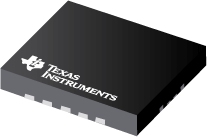Datasheet Texas Instruments TPS54622RHLT — Ficha de datos
| Fabricante | Texas Instruments |
| Serie | TPS54622 |
| Numero de parte | TPS54622RHLT |

Entrada de 4.5 V a 17 V, convertidor SWIFT ™ sincrónico Step-Down 6-A con protección Hiccup 14-VQFN -40 a 150
Hojas de datos
TPS54622 4.5-V to 17-V Input, 6-A Synchronous Step-Down SWIFTв„ў Converter With Hiccup Protection datasheet
PDF, 1.7 Mb, Revisión: E, Archivo publicado: dic 22, 2016
Extracto del documento
Precios
Estado
| Estado del ciclo de vida | Activo (Recomendado para nuevos diseños) |
| Disponibilidad de muestra del fabricante | No |
Embalaje
| Pin | 14 |
| Package Type | RHL |
| Industry STD Term | VQFN |
| JEDEC Code | S-PQFP-N |
| Package QTY | 250 |
| Carrier | SMALL T&R |
| Device Marking | 54622 |
| Width (mm) | 3.5 |
| Length (mm) | 3.5 |
| Thickness (mm) | .9 |
| Pitch (mm) | .5 |
| Max Height (mm) | 1 |
| Mechanical Data | Descargar |
Paramétricos
| Control Mode | Current Mode |
| Duty Cycle(Max) | 98 % |
| Iout(Max) | 6 A |
| Iq(Typ) | 0.6 mA |
| Operating Temperature Range | -40 to 150 C |
| Package Group | VQFN |
| Rating | Catalog |
| Regulated Outputs | 1 |
| Special Features | Enable,Frequency Synchronization,Power Good,Pre-Bias Start-Up,Synchronous Rectification,Tracking |
| Switching Frequency(Max) | 1600 kHz |
| Switching Frequency(Min) | 200 kHz |
| Type | Converter |
| Vin(Max) | 17 V |
| Vin(Min) | 4.5 V |
| Vout(Max) | 15 V |
| Vout(Min) | 0.6 V |
Plan ecológico
| RoHS | Obediente |
Kits de diseño y Módulos de evaluación
- Evaluation Modules & Boards: TPS54622EVM-012
Evaluation Module for TPS54622 Synchronous Step Down SWIFTВ™ Converter
Estado del ciclo de vida: Activo (Recomendado para nuevos diseños)
Notas de aplicación
- Calculating EfficiencyPDF, 175 Kb, Archivo publicado: feb 19, 2010
This application report provides a step-by-step procedure for calculating buck converter efficiency and power dissipation at operating points not provided by the data sheet. - Designing Type III Compensation for Current Mode Step-Down Converters (Rev. A)PDF, 298 Kb, Revisión: A, Archivo publicado: sept 15, 2010
One of the well-known benefits of current-mode control is that the system stability can be easily achieved by Type II compensation design. It is possible to improve the transient response of a current mode DC/DC converter by adopting Type III compensation to boost the crossover frequency and phase margin. Type III compensation is simple to design and needs only one extra component. - Understanding Thermal Dissipation and Design of a HeatsinkPDF, 59 Kb, Archivo publicado: mayo 4, 2011
Power dissipation performance must be well understood prior to integrating devices on a printed-circuit board (PCB) to ensure that any given device is operated within its defined temperature limits. When a device is running, it consumes electrical energy that is transformed into heat. Most of the heat is typically generated by switching devices like MOSFETs, ICs, etc. This application report discu - Semiconductor and IC Package Thermal Metrics (Rev. C)PDF, 201 Kb, Revisión: C, Archivo publicado: abr 19, 2016
Linea modelo
Serie: TPS54622 (3)
- SN1208058RHLR TPS54622RHLR TPS54622RHLT
Clasificación del fabricante
- Semiconductors > Power Management > Non-isolated DC/DC Switching Regulator > Step-Down (Buck) > Buck Converter (Integrated Switch)